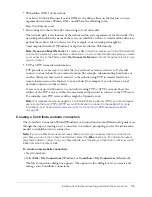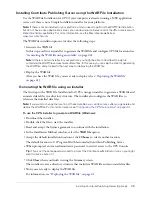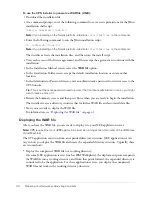
48
Configuring Contribute and Contribute Publishing Server to work with your website
About Contribute administrative settings
Contribute administrative settings are a collection of settings that apply to all users of your
website. These settings let you fine-tune Contribute to provide a better user experience. The
Contribute administrative settings are as follows:
Users and Roles
lets you add users to the site, and create, edit, and delete roles.
Administration
lets you specify a primary administrator for the site, set an administrator
password, and remove administration.
Tip:
Contribute does not require that you set an administrator password; however, you should create
a password to protect access to the administrative functions. If you fail to assign an administrator or
an administrative password, anyone with a Contribute connection to the site can make themselves an
administrator of that site.
Publishing Server
lets you enable your website connection to use CPS—a suite of applications
running on a server that lets you extend the capabilities of Contribute, as well as provide
additional functionary for users.
Note:
If you will be using the CPS User Directory service, you should enable CPS and the User
Directory service before adding users to the site. When you start the User Directory service, any users
who have connected to the site are removed, and any connection keys you might have sent to users
become disabled. To learn more about CPS, see
“Understanding Contribute user management
models” on page 5
.
Web Server
lets you configure Contribute to work with your website’s specific web server
configuration. Because all websites vary somewhat in how they are set up, the configuration
options in the Web Server dialog box let you specify settings specific to your website, which
Contribute might not be able to determine automatically.
To learn more about the web server configuration settings you can specify, see “Web server index
pages” and “Alternate website addresses” in Macromedia Contribute Help.
Rollbacks
lets you enable rollback files and specify the number of rollback files to maintain on
the server.
To learn more about rollbacks, see “Enabling and disabling rollbacks” in Macromedia Contribute
Help.
New pages
lets you specify the encoding used for characters in web pages and the default page
extension (.htm, .html, and so on) to use when creating new pages.
By default, the character encoding for new pages is set to Western, which applies to all English
and Western European languages. The default encoding is set from your computer operating
system’s default encoding. Additional options include Central European, Cyrillic, Greek,
Icelandic, Japanese, Traditional Chinese, Simplified Chinese, and Korean. If you want to create
pages that display characters for multiple languages, select UTF-8.
To learn more about preference settings for new pages, see “Specifying new page preferences” in
Macromedia Contribute Help.
















































